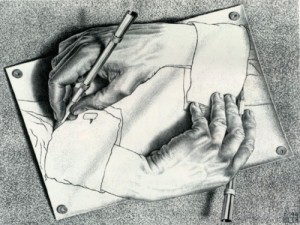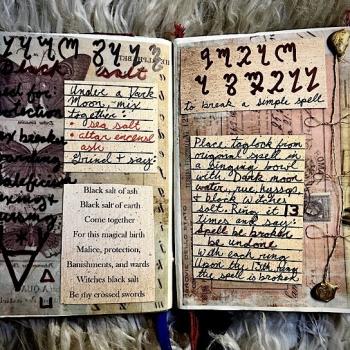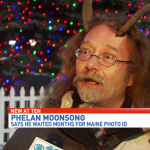 In writing about the apparent contradiction of a monist and pluralistic view of divinity, Starhawk explains, “Witchcraft holds to the truth of paradox and sees each view as equally valid.” (The Spiral Dance). The same could be said of much of Neo-Paganism more generally. In my own understanding of it, Neo-Paganism is a paradoxical religion which holds that the complexity of divinity cannot be contained in any one creed or any single image of divinity. Therefore, my Neo-Paganism embraces paradox. Below is a primer on my Neo-Pagan theology encapsulated in nine paradoxes (all starting with “P”):
In writing about the apparent contradiction of a monist and pluralistic view of divinity, Starhawk explains, “Witchcraft holds to the truth of paradox and sees each view as equally valid.” (The Spiral Dance). The same could be said of much of Neo-Paganism more generally. In my own understanding of it, Neo-Paganism is a paradoxical religion which holds that the complexity of divinity cannot be contained in any one creed or any single image of divinity. Therefore, my Neo-Paganism embraces paradox. Below is a primer on my Neo-Pagan theology encapsulated in nine paradoxes (all starting with “P”):
1. Panentheism – immanence and transcendence
Paradox: God/dess and the world are the same … but different.
In his book Sacred Interconnections, David Ray Griffen explains that panentheism means that “God is not remote and separate from nature, but immanent within it. Yet at the same time God is the unity which transcends it.” Like pantheism, pan-en-theism holds that God/dess is “in” the world. But panentheism also holds that God/dess is “bigger” than the world. From my Neo-Pagan perspective, God/dess is present in the manifest world, but is also the unmanifest potentiality that is “present” in every moment: the tree that is present in the seed, the winter that is present in the summer day, the death that is present in every life.
Quotes:
“Immortal is Isis, mortal her husband, like the earthly creation he represents.” — Bachofen, quoted in Margot Adler, Drawing Down the Moon
“She [the Great Goddess] was […] the arch personification of the power of Space, Time, and Matter, within whose bound all beings arise and die: the substance of their bodies, configurator of their lives and thoughts, and receiver of their dead. And everything having form or name—including God personified as good or evil, merciful or wrathful—was her child, within her womb.” — Joseph Campbell, The Masks of God, Vol. 3
“The Goddess is the Encircler, the Ground of Being; the God is That-Which-Is-Brought-Forth, her mirror image, her other pole. She is the earth; He is the grain. She is the all encompassing sky; He is the sun, her fireball. She is the Wheel; He is the traveler. He is the sacrifice of life to death that life may go on. She is the Mother and Destroyer; He is all that is born and is destroyed.” — Starhawk, The Spiral Dance
2. Polytheism* – pluralism
Paradox: The gods are many … but one.*
“From a neo-Pagan perspective polytheism is not the belief in a world of separate and distinct Gods but is rather an acceptance of the principle that reality and the divine is multiple, fragmented and diverse.” (Waldron, The Sign of the Witch). “It is the reality experienced by men and women when Truth with a capital ‘T’ cannot be articulated according to a single grammar, a single logic or a single symbol system.” (David Miller, The New Polytheism). According to the theologian, William Hamilton, the gods of Neo-Pagan polytheism are not to be believed in, but are “to be used to give shape to an increasingly complex and variegated experience of life.” (quoted by Margot Adler, Drawing Down the Moon). My Neo-Pagan polytheism is a recognition of “the radical plurality of the self.” (Miller).
Quotes:
“All gods are one god. All goddesses are one goddess. And there is one Initiator. She is called by many names by many men, but to all she is the Great Goddess, space and earth and water.” — Dion Fortune, Aspects of Occultism
“In varying degrees and and upon different levels all gods and goddesses represent aspects of One God Which is both ‘male’ and ‘female’.” — Dion Fortune, Applied Magic
“‘All the gods are one god and all the goddesses are one goddess, and there is one initiator.’ The one initiator is one’s own high self, with which the personality becomes more and more integrated as the path of spiritual evolution is followed.” — Doreen Valiente, Witchcraft for Tomorrow
3. Polarity – complementary opposition
Paradox: God is male … and God is female. (i.e., the phallic and yonic cosmic principles are complementary opposites.)
Paradox: The gods are light (Ouranian) … and the gods are dark (Chthonian).
While this kind of dualism unfortunately has been used to support gender and racial oppression, at its core it just means that opposition in nature and the psyche can be creative. Either pole of this opposition may be manifested or symbolized by any gender or none.
Quotes:
“For two are the mystical pillars, that stand at the gate of the shrine, And two are the powers of Nature, the forms and the forces divine.” — Doreen Valiente, The Witches Creed
Pagans “see the universe as fluidly moving between two equal and opposite poles: the female principle, the Goddess, and the male principle, the God. […] The two interactive principles operate in all areas of existence, as in Chinese Taoism, with its principles of Yin and Yang, or perhaps as in the Empedoclean world-view, with its erotic/argumentative metaphor of the twin principles of Love and Strife. This gives a creative universe based on encounter and transformation, rather than a hierarchical one based on dominance and control.” — Prudence Jones, “Pagan Theologies”
4. Process – process theology
Paradox: God/dess is a verb. That is, God/dess (a subject) is a verb (a predicate). God/dess is the Dancer and the Dance.
The fundamental insight of process theology is that reality is change. Change, motion, flux: these are the fundamental realities. Objects, things, moments in time: these are abstractions and unreal. This is true of all reality, including God/dess and ourselves.
Quotes:
“She changes everything she touches. And everything she touches changes.” — Starhawk (chant)
“[T]he shape-shifiting, all-encompassing Goddess is a personification of the unending, unbroken sacred cycle of Birth-Death-Rebirth found throughout the cosmos. Nature is experienced as the Goddess’s ever-changing, cycling, divine Body-Self-Wisdom.” — Donna Wilshire, Virgin Mother Crone
“While life is in us, we must live in the world, where the Dance is, and to live truly, we must join the Dance. There is no reason for this. There is no reason for the world, only the rhyme and the rhythm of the days and nights and the four seasons, without us and within. Life is a Dance and the beginning and end of our lives are steps only; the Dance goes on with us and without us. In time and space, we, as all things, arise and dance and in due time slow and cease to be. But the Dance continues. The Dance is; it always is.” — Michael Adam, Wandering in Eden: Three Ways to the East Within Us
5. Palingenesis – the eternal recurrence of birth
Paradox: The beginning is the end and the end is the beginning.
One of the most important insights of the Neo-Pagan metaphysic for me is the recognition that new life depends on death and that death can only be conquered by accepting it and being reborn. This is how I understand Joseph Campbell’s statement that all truly creative acts derive from some sort of dying. The power of the the Goddess and her Consort is both creative and destructive, the one necessitating the other. Hence the myriad stories of the dying-and-reviving god. This is manifest on both the cosmic and personal levels. On the cosmic level, it is reflected in the biological “circle of life” and the seasons. On the personal level, it is reflected in both the biological life-cycle as well as the psychological ‘deaths’ that we must endure in order to be reborn to a fuller life.
Quotes:
“If life does not change, it dies, and yet paradoxically we are so frightened of death that we try to hold back the flow of life. Without knowing it, we are caught in a masculine idealized image, a longing for perfection that denies the feminine with its understanding of darkness, decay, and destruction. Without darkness there can be no birth; nothing creative can take place. Without destruction there can be no cycle of life, only a sterile environment in which nothing grows. If we do not accept the darkness, life will lose whatever meaning it has left.” — Llewellyn Vaughan-Lee, Working With Oneness
“All mortal things, by necessity of Nature, revolve in a wheel of changes. […] When they are born they grow, and when they are grown they reach their height, and after that they grow old, and at last perish. At one time Nature causes them to come to their goal in her region of darkness, and then again out of the darkness they come back into mortal form, by alternation of birth and repayment of death, in the cycle wherein Nature returns upon herself.” — Hippodamus the Pythagorean, quoted in Stobaeus, Florilegium (transl. Francis Cornford)
6. Parthenogenesis – virgin birth
Paradox: God is male and female … but God is female first.
While my Neo-Pagans honors deities of all genders, I understand the Goddess as ontologically prior.
Quotes:
“Mother Earth, unbegotten and self-delivered.” — Nonnus, Dionysiaca
“To Witches, the cosmos is the living body of the Goddess, in whose being we all partake, who encompasses us and is immanent within us. We call her Goddess not to narrowly define her gender, but as a continual reminder that what we value is life brought into the world […] She has infinite names and guises, many of them male.” — Starhawk, Truth or Dare
7. Pansacramentalism
Paradox: Everything is sacred … but we have to work to make it sacred.
Neo-Pagans see the world as sacred. But it seems to be a consequence of the modern human condition that we can become alienated from that sacred quality. Many Neo-Pagans call this “disenchantment”. Our challenge then is to “resacralize” the world, to make manifest existentially the essential sacredness of the world which is always already present.
Quotes:
“Stay away from anything that obscures the place it is in. There are no unsacred places. There are only sacred places and desecrated places.” — Wendell Berry, “How to Be a Poet”
“The salvation of man does not lie in his holding himself far removed from the worldly, but in consecrating it to holy, to divine meaning.” — Martin Buber, Hasidism and Modern Man
“Everything is full of sacramental substance, everything. Each thing and each function is ever ready to light up into a sacrament.” — Martin Buber
8. Panzoism
Paradox: Everything is alive … even dead stuff.
One expression of this belief is the Gaia hypothesis, that the Earth as a whole is a living organism. It may also refers to the belief in an immanent or indwelling life principle which permeates all matter, or the belief that matter is oriented towards life, that life is latent in matter.
Quotes:
“This world is indeed a living being endowed with a soul and intelligence […] a single visible living entity containing all other living entities, which by their nature are all related.” — Plato, Timaeus
“To the Etruscan all was alive; the whole universe lived; and the business of man was himself to live amid it all. He had to draw life into himself, out of the wandering huge vitalities of the world. The cosmos was alive, like a vast creature. The whole thing breathed and stirred. […] The whole thing was alive, and had a great soul, or anima : and in spite of one great soul, there were myriad roving, lesser souls; every man, every creature and tree and lake and mountain and stream, was animate, had its own peculiar consciousness. And has it to-day.” — D.H. Lawrence, Etruscan Places
9. Psychologization of religion and sacralization of psychology
Paradox: The gods are archetypes … but they are not just archetypes.
Wouter Hanegraaff describes a phenomenon in the New Age (including Neo-Paganism) toward a “psychologizing of religion combined with a sacralization of psychology.”
“In Jungian fashion, the ‘gods’ of traditional pantheons are often interpreted as archetypes, and reversely the archetypes of the collective unconscious are seen as powerful numinous realities. In other words, traditional religious concepts are reinterpreted in psychological terms; but because psychology itself is embedded in an encompassing religious framework New Age authors can avoid the traditional reductionist conclusion that the gods are unreal because they exist only ‘in the mind.'”
The psychologization of religion and sacralization of psychology in Neo-Paganism and the New Age can be traced back to Emerson, William James, Jung and transpersonal psychology. According to Robert Fuller,
“When William James interpreted the unconscious as humankind’s link with a spiritual ‘more’, he gave shape to a peculiarly modern spirituality. James’ vision of the unconscious depths of human personality as at once psychological and spiritual made it possible for modern Americans to view self-exploration as spiritually significant and religious experience as psychologically profound. […] The ‘fact’ that God can be approached through our own unconscious minds suggests that only a self-imposed, psychological barrier separates us from an immanent divinity. The cultivation of receptivity to the unconscious is thus a spiritually as well as psychologically regenerative act of the whole personality.”
According to Hanegraaff, Jung’s theories “enabled people to talk about God while really meaning their own psyche, and about their own psyche while really meaning the divine.”
Quotes:
“[…] the age-old question, ‘Are the Gods real?’ […] From the point of view of the psychic value of myth, ritual and symbolism, the somewhat surprising answer to the question is, ‘It doesn’t matter’. […] their importance to the human psyche is beyond doubt in either case, and the techniques for coming to healthy and fruitful terms with them can be used by believers and non-believers alike. […] ‘Whether the archetypal God-forms are cosmically divine, or merely the living foundation-stones of the human psyche, we would be wise to seek intercourse with them as though they were divine’. Myth and ritual bring about nourishing communication with the Archetypes, and because of the nature and evolution of the human psyche, the symbolism or myth or ritual—their only effective vocabulary—is basically religious.” — Janet and Stewart Farrar, The Witches Way
“The purpose of Wicca, as a religion, is to integrate conflicting aspects of the human psyche with each other, and the whole with the Cosmic Psyche.” — Janet and Stewart Farrar, The Witches’ Way
“The Gods and Goddesses of myth, legend and fairy tale represent archetypes, real potencies and potentialities deep within the psyche, which, when allowed to flower permit us to be more fully human.” — Margot Adler, Drawing Down the Moon
“The purpose of ritual is to wake up the old mind in us, to put it to work. The old ones inside us, the collective unconscious, the many lives, the divine eternal parts, the senses and parts of the brain that have been ignored.” — Z. Budapest, quoted in Margot Adler, Drawing Down the Moon
* Note: There are those within and without the Pagan community who identify as polytheists who adamantly reject any hint of monism or of psychologism, including many “hard” polytheists, devotional polytheists, and reconstructionists. While some of these individuals identify as “Pagan”, most distinguish themselves from “Neo-Pagans” like myself. As has been noted in the comments, however, even this is not a hard and fast rule. There are many forms of polytheism. The kind described here is just one kind.















